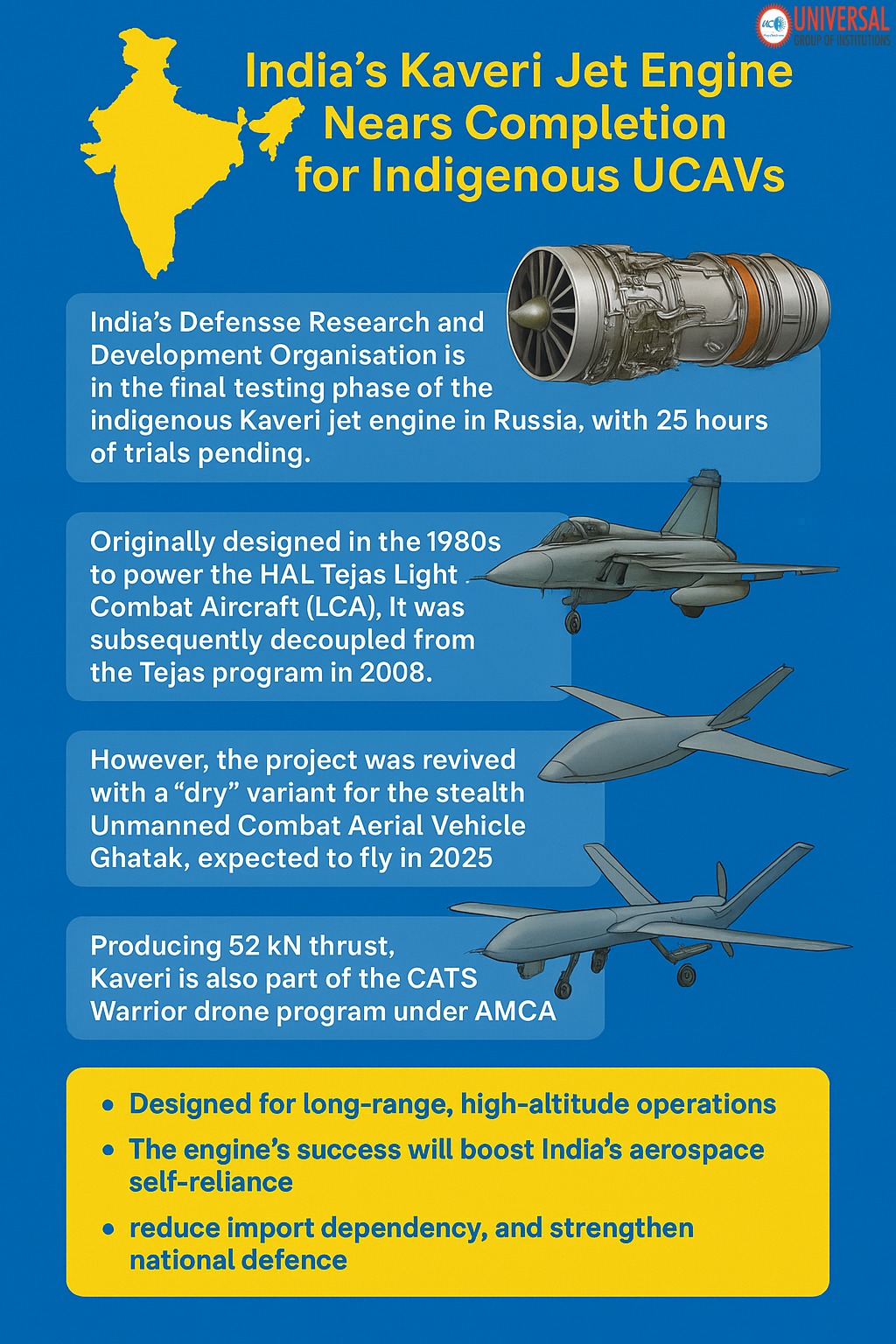India’s Kaveri Jet Engine Nears Completion for Indigenous UCAVs and Fighter Drones
India’s Kaveri Jet Engine Nears Completion for Indigenous UCAVs and Fighter Drones
India’s defense innovation landscape is poised for a historic leap as the indigenous Indian jet engine, Kaveri, edges closer to completion. Developed by the GTRE DRDO (Gas Turbine Research Establishment under the Defence Research and Development Organisation), this turbofan engine is expected to power India’s upcoming Unmanned Combat Aerial Vehicle (UCAV) projects, including advanced stealth drones. The development signifies not just a technological achievement in turbine engine technology but also a critical stride toward self-reliance in aerospace defense systems, embodying the spirit of “Make in India” defense initiatives.
From Tejas to Tactical UAVs: The Kaveri Journey
Launched in the late 1980s, the Kaveri engine was initially conceptualized to power the Light Combat Aircraft (LCA) Tejas. However, persistent technological hurdles, including issues with Kaveri engine thrust and reliability, led to its replacement in Tejas by American GE-404 engines. Despite being sidelined in manned fighter programs, the project was not abandoned. Instead, it evolved to suit emerging needs in unmanned warfare platforms, particularly the development of stealthy UCAVs and fighter drones, aligning with India’s broader “Make in India” defense strategy.
Technological Maturity and Testing Progress
The Kaveri engine has undergone rigorous testing over the years, including high-altitude trials conducted in Russia. As of May 2025, only about 25 hours of test time remain—a milestone that signals the final phase of development. These tests are pivotal in validating the engine’s efficiency, thermal management, and sustained performance under diverse flight conditions.
A significant spinoff from the main engine is the Kaveri Derivative Engine (KDE)—a dry variant, non-afterburning version tailored specifically for UCAV applications. Producing up to 48 kN of thrust, this version uses advanced composite materials and next-generation cooling systems. Domestic industry partners like Godrej Aerospace have also contributed to this effort by manufacturing critical components, enhancing both technological depth and public-private sector participation in defense manufacturing, further strengthening the “Make in India” defense ecosystem.
Strategic Impact and Future Role
The completion of the Kaveri engine marks a turning point in India’s strategic defense capabilities. Its primary application will be in powering the DRDO Ghatak, a stealthy UCAV being developed for deep-strike missions and high-risk operations without endangering pilots. The Ghatak UCAV, also known as the India UCAV project, features a flying wing UAV design that incorporates stealth technology and an internal weapons bay, positioning it as a formidable stealth drone.
Beyond Ghatak, the technological base built through the Kaveri program will likely feed into future projects like the Advanced Medium Combat Aircraft (AMCA)—India’s indigenous 5th-generation stealth fighter under development. The experience and infrastructure cultivated through Kaveri are thus not limited to one platform but lay the groundwork for a new generation of aircraft engines, including potential applications in Indian stealth bombers and even contributing to advancements in missile technology, such as the Agni missile series.
Development Process and Collaborations
The Aeronautical Development Establishment (ADE) and ADA (Aeronautical Development Agency) have been instrumental in the UCAV development process. As a precursor to the Ghatak project, the Stealth Wing Flying Testbed (SWiFT) was developed to validate the flying-wing concept and autonomous flight control systems. SWiFT, serving as a technology demonstrator, has provided valuable data for the larger UCAV program, particularly in areas of stealth technology and autonomous operations.
The SWiFT program has been crucial in refining the autonomous capabilities and flight control systems of future UCAVs. By testing advanced flight control systems in a scaled-down model, engineers have been able to validate key technologies that will be implemented in the full-scale Ghatak stealth drone.
While the Kaveri engine remains the primary focus, alternative power plants such as the TRDD-50MT turbofan engine and NPO Saturn 36MT have been considered during the development phase. These options ensure that the program has fallback solutions if needed, though the preference remains for the indigenous Kaveri engine to support the “Make in India” defense initiative.
Potential Applications and Users
Both the Indian Air Force and Indian Navy have shown interest in the UCAV program. While the Air Force is primarily focused on land-based operations, the Navy is exploring the potential for deck-based UCAVs that could operate from aircraft carriers. This dual-use approach highlights the versatility of the Ghatak platform and its underlying technologies.
The UCAVs are expected to be equipped with advanced data link packages and sophisticated flight control systems, allowing for real-time communication and coordination with other assets. This capability, combined with the flying wing design and internal weapons bay, positions the Ghatak as a formidable autonomous stealth drone capable of penetrating heavily defended airspace.
Public Sentiment and Civilian Advocacy
In recent months, public support for the Kaveri project has surged, largely amplified through the viral #FundKaveriEngine campaign. Defense enthusiasts, technologists, and ordinary citizens alike have called upon the government to bolster investment in the project. Many view it as a symbol of India’s potential to stand shoulder-to-shoulder with global aerospace leaders in jet engine technology and autonomous combat systems, further solidifying the country’s commitment to “Make in India” defense initiatives.
Conclusion: A Jet Engine, A National Statement
The nearing fruition of the Kaveri jet engine project stands as a testament to India’s unwavering pursuit of defense autonomy. It reflects decades of indigenous R&D, resilience through setbacks, and strategic vision. Once fully operational, the Kaveri engine won’t just power a UCAV—it will power a narrative of national pride, innovation, and self-reliance in the realm of advanced gas turbines and stealth drones.
India’s ability to develop and deploy an indigenous jet engine will significantly reduce dependence on foreign technologies, offer strategic deterrence, and showcase the country’s readiness to lead in next-generation warfare systems. Continued investment and sustained policy support will be key to transforming this potential into operational success, further solidifying India’s position in the global defense landscape.
As DRDO news continues to highlight progress in the Kaveri engine development, it becomes clear that this project is not just about a single engine, but about propelling India’s entire defense sector forward. The success of the Kaveri engine and the associated UCAV programs represent significant India defense updates, marking a new chapter in the nation’s journey towards technological sovereignty in aerospace and defense. This achievement not only bolsters India’s stealth drone capabilities but also paves the way for future developments in Indian stealth bomber technology, showcasing the country’s growing prowess in advanced military aviation and reinforcing the success of the “Make in India” defense strategy.












